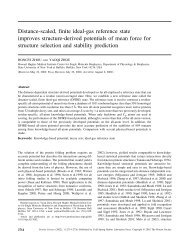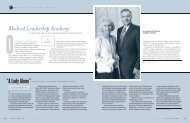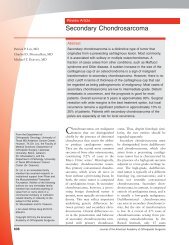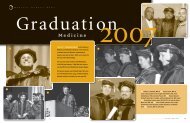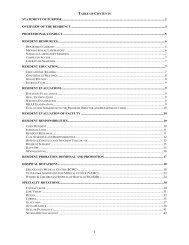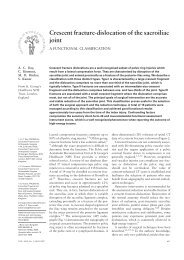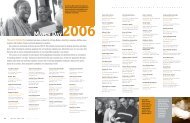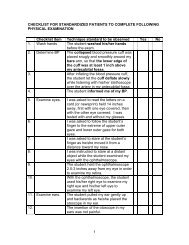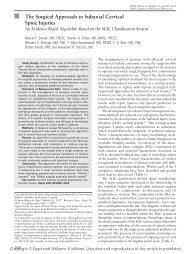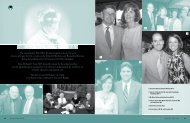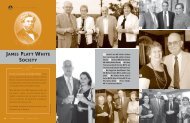Anterior Acromioplasty for the Chronic Impingement Syndrome in ...
Anterior Acromioplasty for the Chronic Impingement Syndrome in ...
Anterior Acromioplasty for the Chronic Impingement Syndrome in ...
You also want an ePaper? Increase the reach of your titles
YUMPU automatically turns print PDFs into web optimized ePapers that Google loves.
<strong>Anterior</strong> <strong>Acromioplasty</strong> <strong>for</strong> <strong>the</strong> <strong>Chronic</strong><br />
I mp<strong>in</strong>gement <strong>Syndrome</strong> <strong>in</strong> <strong>the</strong> Shoulder<br />
A PRELIMINARY REPORT<br />
BY CHARLES S. NEER II, M.D.t, NEW YORK, N. Y.<br />
Fron <strong>the</strong> Departtnent of Orthopaedie Surgery, College of Physicians and<br />
Surgeons, Columbia University, and The New York Orthopaedic Hospital,<br />
Columbia-Presbyterian Medical Center, New York<br />
<strong>Imp<strong>in</strong>gement</strong> of <strong>the</strong> rotator cuff beneath <strong>the</strong> coraco-acromial arch has been<br />
recognized as one of <strong>the</strong> causes of chronic disability of <strong>the</strong> shoulder 1.5,6 7,9, 10 Cornplete<br />
acromionectonly 1,5,10 and lateral acromionectomy 6.9 at various levels have<br />
been advocated <strong>for</strong> <strong>the</strong> condition. Disappo<strong>in</strong>tment with <strong>the</strong> results of <strong>the</strong>se procedunes,<br />
because of weaken<strong>in</strong>g of <strong>the</strong> leverage of <strong>the</strong> deltoid muscle, displacement of<br />
<strong>the</strong> attachments of <strong>the</strong> orig<strong>in</strong> of <strong>the</strong> deltoid, <strong>for</strong>mation of s<strong>in</strong>uses with bursal or jo<strong>in</strong>t<br />
fluid dra<strong>in</strong><strong>in</strong>g through <strong>the</strong> sk<strong>in</strong>, deep scars, and, <strong>in</strong> <strong>the</strong> case of lateral acroniionectomy,<br />
<strong>the</strong> persistence of symptoms because of residual imp<strong>in</strong>gement, stimulated us<br />
to a new study of <strong>the</strong> role, <strong>in</strong> <strong>the</strong> imp<strong>in</strong>gement syndrome, of <strong>the</strong> undersurface of <strong>the</strong><br />
acrom<br />
ion.<br />
This paper describes relevant anatomical f<strong>in</strong>d<strong>in</strong>gs and <strong>the</strong> rationale, <strong>the</strong> <strong>in</strong>dications,<br />
<strong>the</strong> technique, and <strong>the</strong> prelim<strong>in</strong>ary results ofanterior acromioplasty, which has<br />
been a procedure per<strong>for</strong>med <strong>in</strong> our cl<strong>in</strong>ic s<strong>in</strong>ce I 965.<br />
Anatomical<br />
Considerations<br />
Inspection of 100 dissected scapulae with special attention to <strong>the</strong> acromion<br />
revealed alterations attributable to mechanical imp<strong>in</strong>gement <strong>in</strong> eleven. The ages of<br />
<strong>the</strong> cadavera were unknown but <strong>the</strong> majority were <strong>in</strong> <strong>the</strong> sixth decade or older. A<br />
characteristic ridge of proliferative spurs and excrescences on <strong>the</strong> undersurface<br />
of <strong>the</strong> anterior process was seen frequently, apparently caused by repeated imp<strong>in</strong>gement<br />
of <strong>the</strong> rotator cuff and humeral head, with traction on <strong>the</strong> coracoacromial ligament,<br />
and it was quite prom<strong>in</strong>ent <strong>in</strong> eight specimens (Fig. 1 -A). Eburnation with<br />
erosion of <strong>the</strong> acromion was thought to be a later manifestation, and was found <strong>in</strong><br />
three specimens (Fig. 1-B). Without exception, it was <strong>the</strong> anterior lip and undersurface<br />
of <strong>the</strong> anterior third that was <strong>in</strong>volved. In one scapula, <strong>the</strong> eburnation and<br />
erosion, accompanied by an old massive cuff tear, extended somewhat fur<strong>the</strong>r toward<br />
<strong>the</strong> center of <strong>the</strong> acrom ion but <strong>the</strong> posterior third was spared.<br />
My observations at surgery have consistently supported <strong>the</strong> hypo<strong>the</strong>sis that <strong>the</strong><br />
critical area <strong>for</strong> degenerative tend<strong>in</strong>itis and tendon rupture is centered <strong>in</strong> <strong>the</strong> suprasp<strong>in</strong>atus<br />
tendon, extend<strong>in</strong>g at times to <strong>in</strong>clude <strong>the</strong> anterior part of <strong>the</strong> <strong>in</strong>frasp<strong>in</strong>atus<br />
tendon and <strong>the</strong> long head of <strong>the</strong> biceps (Fig. 2). However, it has not been adequately<br />
emphasized that, with <strong>the</strong> arm <strong>in</strong> <strong>the</strong> anatomical position, all of <strong>the</strong>se structures<br />
lie anterior to <strong>the</strong> acromion. With <strong>in</strong>ternal rotation, <strong>the</strong> position <strong>in</strong> which <strong>the</strong><br />
arni is often used, <strong>the</strong>y are brought even more anterior. With external rotation, <strong>the</strong><br />
facet <strong>for</strong> <strong>the</strong> <strong>in</strong>sertion of <strong>the</strong> suprasp<strong>in</strong>atus lies just lateral to <strong>the</strong> anterior third of<br />
* Read at <strong>the</strong> Annual Meet<strong>in</strong>g of The American Orthopaedic Association, Hot Spr<strong>in</strong>gs,<br />
Virg<strong>in</strong>ia, June 21, 1971.<br />
t 161 Fort Wash<strong>in</strong>gton Avenue, New York, N. Y. 10032.<br />
VOL. 54-A, NO. 1, JANUARY 1972 41
42 C. S. NEER, II<br />
FI;. 1-A FIG. 1-B<br />
Figs. 1-A and I -B: Photographs of <strong>the</strong> undersurface of <strong>the</strong> acromion of elderly cadavera.<br />
Fig. 1-A: Show<strong>in</strong>g a large anterior acromial spur and excrescences of <strong>the</strong> anterior third,<br />
thought characteristic of chronic imp<strong>in</strong>gement with traction on <strong>the</strong> coraco-acromial ligament.<br />
Spatial relations can be determ<strong>in</strong>ed by <strong>the</strong> location of <strong>the</strong> articular facet <strong>for</strong> <strong>the</strong> clavicle.<br />
Fig. 1-B: Ano<strong>the</strong>r specimen show<strong>in</strong>g erosion of this area and eburnation, which appeared to<br />
be a later manifestation.<br />
<strong>the</strong> acromion (Fig. 3). Thus, elevation of <strong>the</strong> arm <strong>in</strong> <strong>in</strong>ternal rotation or <strong>in</strong> <strong>the</strong> anatomical<br />
position of external rotation causes <strong>the</strong> critical area to pass under <strong>the</strong> coracoacromial<br />
ligament or <strong>the</strong> anterior process of <strong>the</strong> acromion. The critical area does not<br />
touch <strong>the</strong> posterior two-thirds of <strong>the</strong> acromion. With scapular rotation <strong>the</strong> acromion<br />
is tilted backwards, leav<strong>in</strong>g <strong>the</strong> anterior process as <strong>the</strong> lead<strong>in</strong>g edge.<br />
At about 80 degrees of abduction, <strong>the</strong> critical area of <strong>the</strong> suprasp<strong>in</strong>atus tendon<br />
passes beneath <strong>the</strong> acroniioclavicularjo<strong>in</strong>t and thisjo<strong>in</strong>t tilts with overhead elevation<br />
of <strong>the</strong> arm. With <strong>the</strong> jo<strong>in</strong>t <strong>in</strong> this position, it is logical to assume that excrescences on<br />
<strong>the</strong> undersurface of <strong>the</strong> anterior marg<strong>in</strong> of <strong>the</strong> acromion may imp<strong>in</strong>ge on <strong>the</strong> cuff.<br />
Arthrograms seem to substantiate this po<strong>in</strong>t.<br />
One <strong>the</strong>sis of this study is that a lateral acromionectomy not only weakens <strong>the</strong><br />
deltoid unnecessarily, which is especially bad when <strong>the</strong> rotator cuff is deficient, but<br />
also removes an <strong>in</strong>nocent part of <strong>the</strong> acromion, that part posterior to <strong>the</strong> site of<br />
pathological <strong>in</strong>volvement. It seems important that <strong>the</strong> rough surface on which <strong>the</strong><br />
suprasp<strong>in</strong>atus tendon is rubb<strong>in</strong>g be removed. One should <strong>the</strong>re<strong>for</strong>e remove <strong>the</strong> anterior<br />
edge and <strong>the</strong> undersurface of <strong>the</strong> anterior process along with <strong>the</strong> attached<br />
coraco-acrornial ligament. If o<strong>the</strong>r pathological areas are discovered at operation,<br />
that is, a hypertrophic acromioclavicular jo<strong>in</strong>t, or spurs and adhesions at <strong>the</strong> long<br />
head of <strong>the</strong> biceps or greater tuberosity, <strong>the</strong>y too should be removed. The attachments<br />
of <strong>the</strong> deltoid should be m<strong>in</strong>imally disturbed.<br />
Material<br />
Dur<strong>in</strong>g <strong>the</strong> years 1965 to 1970, fifty shoulders of <strong>for</strong>ty-six patients were operated<br />
on by <strong>the</strong> method to be described. The pathological f<strong>in</strong>d<strong>in</strong>gs <strong>in</strong> <strong>the</strong> suprasp<strong>in</strong>atus<br />
tendon consisted of tend<strong>in</strong>itis or partial tears <strong>in</strong> n<strong>in</strong>eteen shoulders, complete tears <strong>in</strong><br />
twenty, and evidences of residual imp<strong>in</strong>gement follow<strong>in</strong>g lateral acromionectomy <strong>in</strong><br />
THE JOURNAL OF BONE AND JOINT SURGERY
ANTERIOR ACROMIOPLASTY 43<br />
AIc<br />
cw ELEVTIOP1’fl<br />
Fu. 2 FI(;. 3<br />
Fig. 2: Illustrat<strong>in</strong>g <strong>the</strong> relationships of <strong>the</strong> critical area with <strong>the</strong> coraco-acromial arch when<br />
<strong>the</strong> arm is held <strong>in</strong> <strong>the</strong> anatomical position. Note <strong>the</strong> overlapp<strong>in</strong>g <strong>in</strong>sertion of <strong>the</strong> <strong>in</strong>frasp<strong>in</strong>atus<br />
and <strong>the</strong> proximity of <strong>the</strong> bicipital groove. The critical area is anterior to <strong>the</strong> acromion.<br />
Fig. 3: Draw<strong>in</strong>g to show that with elevation <strong>in</strong>to any of <strong>the</strong> functional arcs, <strong>the</strong> critical zone<br />
at <strong>the</strong> suprasp<strong>in</strong>atus engages <strong>the</strong> anterior third of <strong>the</strong> acromion, not <strong>the</strong> posterior part.<br />
eleven. Patients with roentgenographic evidence of calcification <strong>in</strong> <strong>the</strong> tendon, rheuniatoid<br />
arthritis, fractures, or acute tears were not considered suitable <strong>for</strong> this study,<br />
which was restricted to what was considered mechanical imp<strong>in</strong>gement.<br />
The ages of <strong>the</strong> patients ranged from <strong>for</strong>ty-two to seventy-three years and averaged<br />
S I .5 years <strong>for</strong> those with tend<strong>in</strong>itis or partial tears and 58. 1 years <strong>for</strong> those<br />
with complete tears. Twenty-eight patients were men and eighteen were women. The<br />
right shoulder was <strong>in</strong>volved twice as frequently as <strong>the</strong> left.<br />
Forty-seven shoulders were evaluated from n<strong>in</strong>e nionths to five years follow<strong>in</strong>g<br />
surgery, twenty-n<strong>in</strong>e by exam<strong>in</strong>ation and eighteen by questionnaire and records.<br />
Three shoulders had not been followed <strong>for</strong> <strong>the</strong> m<strong>in</strong>imum period. Follow-up roentgenograms<br />
were obta<strong>in</strong>ed <strong>in</strong> all but six. The average duration of follow-up was two<br />
and one-half years.<br />
Indications <strong>for</strong> Surgery<br />
The procedure to be described was used <strong>in</strong> patients ei<strong>the</strong>r with long-term disability<br />
froni chronic bursitis and partial tears of <strong>the</strong> suprasp<strong>in</strong>atus tendon, or with<br />
complete tears of <strong>the</strong> suprasp<strong>in</strong>atus associated with tears of vary<strong>in</strong>g degree of <strong>the</strong><br />
adjacent rotator cuff. The first lesion is regarded as an early stage of <strong>the</strong> second and<br />
<strong>the</strong> two lesions comprise <strong>the</strong> imp<strong>in</strong>gement syndrome. Calcific deposits <strong>in</strong> <strong>the</strong> rotator<br />
cuff did not necessarily occur at <strong>the</strong> critical area of ililp<strong>in</strong>gement, and <strong>the</strong>y were regarded<br />
as chemical irritants. Patients with such deposits were usually responsive to<br />
simple treatment and were not considered <strong>for</strong> <strong>the</strong> procedure under discussion. N<strong>in</strong>e<br />
patients <strong>in</strong> this series had a history of hav<strong>in</strong>g had such deposits and were found to<br />
have scarred or torn suprasp<strong>in</strong>atus tendons, with or without m<strong>in</strong>ute amounts of calcium<br />
which, when present, were <strong>in</strong>apparent roentgenographically.<br />
S<strong>in</strong>ce <strong>the</strong> physical and roentgenographic f<strong>in</strong>d<strong>in</strong>gs <strong>in</strong> <strong>the</strong> two categories of patients<br />
were <strong>in</strong>dist<strong>in</strong>guishable, arthrograms were required to demonstrate whe<strong>the</strong>r <strong>the</strong><br />
tears were complete. The physical signs <strong>for</strong> both groups of patients <strong>in</strong>cluded crepitus<br />
and tenderness over <strong>the</strong> suprasp<strong>in</strong>atus tendon, a good range of assisted motion but a<br />
VOL. 54-A, NO. I, JANUARY 1972
44 C. S. NEER, II<br />
Fu. 4-A Fic. 4-B<br />
Figs. 4-A and 4-B: Roentgenognams of an anterior acromial spun <strong>in</strong> a man aged fifty-six years.<br />
A three-centimeter complete tear of<strong>the</strong> suprasp<strong>in</strong>atus was found at surgery.<br />
FIg. 4-A: Anteroposterlor roentgenogram show<strong>in</strong>g <strong>the</strong> spur on <strong>the</strong> acromion and a correspond<strong>in</strong>g<br />
excrescence at <strong>the</strong> greater tuberosity and bicipital groove.<br />
FIg. 4-B: Axillary roentgenogram of <strong>the</strong> same patient show<strong>in</strong>g that <strong>the</strong> spur is located at <strong>the</strong><br />
anterior third of <strong>the</strong> acromion. Roentgenographic f<strong>in</strong>d<strong>in</strong>gs at <strong>the</strong> acromion are not always evident<br />
and, when present, may be compatible with normal function although <strong>the</strong> patient appears<br />
to be more vulnerable to m<strong>in</strong>or trauma.<br />
pa<strong>in</strong>ful arc of active elevation from 70 degrees to I 20 degrees, and pa<strong>in</strong> at <strong>the</strong> antenor<br />
edge of <strong>the</strong> acromion on <strong>for</strong>ced elevation. Patients with partial tears seemed<br />
more prone to have a lesser range of motion. The only common roentgenographic<br />
f<strong>in</strong>d<strong>in</strong>g was <strong>the</strong> presence of cysts or sclerosis of <strong>the</strong> greater tuberosity, but on close<br />
<strong>in</strong>spection many roentgenogranis showed correspond<strong>in</strong>g areas of proliferation at <strong>the</strong><br />
anterior edge of <strong>the</strong> acromion (Figs. 4-A and 4-B).<br />
Patients suspected of hav<strong>in</strong>g <strong>in</strong>complete tears were advised not to have surgery<br />
until <strong>the</strong> stiffness of <strong>the</strong> shoulder had disappeared, and <strong>the</strong> disability had to persist<br />
<strong>for</strong> at least n<strong>in</strong>e months be<strong>for</strong>e surgery was per<strong>for</strong>med. Many patients not <strong>in</strong>cluded<br />
<strong>in</strong> <strong>the</strong> series were suspected of hav<strong>in</strong>g imp<strong>in</strong>gement but responded well to conservative<br />
treatment. This suggests that while such patients had pathological changes <strong>in</strong><br />
<strong>the</strong> cuff that were vulnerable to swell<strong>in</strong>g and <strong>in</strong>flammation follow<strong>in</strong>g m<strong>in</strong>or trauma,<br />
<strong>the</strong> acute reaction was reversible. In this series, all patients with <strong>in</strong>complete tears had<br />
had symptoms <strong>for</strong> from ten months to ten years, averag<strong>in</strong>g four years. The effects of<br />
a xyloca<strong>in</strong>e <strong>in</strong>jection beneath <strong>the</strong> acromion or <strong>in</strong>to <strong>the</strong> acromioclavicular jo<strong>in</strong>t was<br />
a useful guide as to what <strong>the</strong> procedure would accomplish.<br />
The patients <strong>in</strong> this series who had complete tears had had symptonis <strong>for</strong> from<br />
six weeks to twelve years. The symptoms sometimes were <strong>in</strong>termittent and often<br />
became more <strong>in</strong>tense a few months prior to surgery. When a complete tear was suspected<br />
and <strong>the</strong>re was no response to conservative treatment <strong>for</strong> six weeks, arthrography<br />
was advised. If <strong>the</strong> arthrogram was positive, surgery was recommended. In<br />
<strong>the</strong> occasional patient who was suspected of hav<strong>in</strong>g a massive cuff avulsion, because<br />
of a history of ni<strong>in</strong>or trauma followed by complete <strong>in</strong>ability to raise <strong>the</strong> arm, we<br />
tried to make <strong>the</strong> arthrogram and to do <strong>the</strong> repair promptly be<strong>for</strong>e <strong>the</strong>re was permanent<br />
shorten<strong>in</strong>g of <strong>the</strong> cuff muscles.<br />
A special <strong>in</strong>dication <strong>for</strong> anterior acromioplasty was residual imp<strong>in</strong>gement and<br />
chronic disability follow<strong>in</strong>g partial lateral acromionectomy. The shoulders of those<br />
patients were decompressed anteriorly accord<strong>in</strong>g to <strong>the</strong> same pr<strong>in</strong>ciple. We tried<br />
to use <strong>the</strong> old sk<strong>in</strong> <strong>in</strong>cision as much as possible and, at times, we did a reconstruction<br />
of <strong>the</strong> central part of <strong>the</strong> orig<strong>in</strong> of <strong>the</strong> deltoid.<br />
This procedure has also been used at <strong>the</strong> time of glenohunieral arthroplasty <strong>for</strong><br />
rheumatoid and degenerative arthritis. These cases are not <strong>in</strong>cluded <strong>in</strong> this study. It<br />
THE JOURNAL OF BONE AND JOINT SURGERY
ANTERIOR ACROMIOPLASTY 45<br />
A.<br />
B.<br />
FIG. 5<br />
Illustrat<strong>in</strong>g detachment and repair of <strong>the</strong> deltoid orig<strong>in</strong>. A: The muscle is split from above<br />
downwards five centimeters and is detached from <strong>the</strong> anterior third of <strong>the</strong> acromion and acromioclavicular<br />
jo<strong>in</strong>t capsule. The tend<strong>in</strong>ous orig<strong>in</strong> on <strong>the</strong> anterior third of <strong>the</strong> acromion is elevated<br />
dorsally prior to remov<strong>in</strong>g bone, expos<strong>in</strong>g <strong>the</strong> anterior edge of <strong>the</strong> acromion and provid<strong>in</strong>g a<br />
rim of tissue <strong>for</strong> repair. B: Secure closure of <strong>the</strong> deltoid is accomplished by sutur<strong>in</strong>g <strong>the</strong> lateral<br />
flap to <strong>the</strong> rim of tend<strong>in</strong>ous tissue on <strong>the</strong> acromion as shown. The medial flap is sutured to <strong>the</strong><br />
capsule of <strong>the</strong> acromioclavicular jo<strong>in</strong>t or, when <strong>the</strong> jo<strong>in</strong>t has been excised, to <strong>the</strong> trapezius<br />
muscle. The split is closed last.<br />
was thought that <strong>the</strong> <strong>in</strong>clusion of results of comb<strong>in</strong>ed procedures <strong>for</strong> o<strong>the</strong>r types of<br />
disease would <strong>in</strong>troduce too many variables to permit an analysis of <strong>the</strong> subacroniial<br />
imp<strong>in</strong>gement<br />
syndrome.<br />
Operative Technique and Postoperative Regimen<br />
The patient was placed high on <strong>the</strong> table, positioned so that <strong>the</strong> po<strong>in</strong>t of <strong>the</strong><br />
affected shoulder protruded over <strong>the</strong> corner of <strong>the</strong> table. The shoulder, which was<br />
draped free, could be fully extended without <strong>in</strong>terference from <strong>the</strong> table. Folded<br />
towels were placed under <strong>the</strong> scapula. The head was supported with an armboard,<br />
avoid<strong>in</strong>g hyperextension. The table was adjusted to <strong>the</strong> beach chair position. The<br />
anes<strong>the</strong>siologist was draped from <strong>the</strong> field; we preferred <strong>in</strong>tratracheal anes<strong>the</strong>sia.<br />
An <strong>in</strong>cision, about n<strong>in</strong>e centimeters long, was made obliquely <strong>in</strong> Langer’s l<strong>in</strong>es<br />
from <strong>the</strong> anterior edge of <strong>the</strong> acromion to just lateral to <strong>the</strong> coracoid. The deep fascia<br />
was <strong>in</strong>cised and <strong>the</strong> deltoid muscle was split from above downward, <strong>in</strong> <strong>the</strong> direction<br />
of its fibers, five centimeters distal to <strong>the</strong> acromioclavicular jo<strong>in</strong>t. Fur<strong>the</strong>r splitt<strong>in</strong>g<br />
jeopardizes <strong>the</strong> axillary nerve. By sharp dissection, anticipat<strong>in</strong>g cutt<strong>in</strong>g <strong>the</strong> acromial<br />
branch of <strong>the</strong> thoraco-acromial artery, <strong>the</strong> deltoid was detached from <strong>the</strong> front of <strong>the</strong><br />
acromion and acromioclavicular jo<strong>in</strong>t capsule (Fig. 5). This exposed <strong>the</strong> coracoacromial<br />
ligament. The claviculopectoral fascia, extend<strong>in</strong>g laterally from this ligament,<br />
was divided to permit plac<strong>in</strong>g a wide elevator under <strong>the</strong> acrom ion. With traction<br />
on <strong>the</strong> arm <strong>the</strong> undersurface of <strong>the</strong> anterior process was palpated manually <strong>for</strong><br />
sharp edges and osteophytes and to determ<strong>in</strong>e <strong>the</strong> thickness of <strong>the</strong> acromion. To<br />
facilitate repair of <strong>the</strong> deltoid, <strong>the</strong> stump of its tend<strong>in</strong>ous orig<strong>in</strong> on <strong>the</strong> anterior<br />
acromion was elevated upward expos<strong>in</strong>g <strong>the</strong> front of <strong>the</strong> acromion and <strong>the</strong> attach-<br />
VOL.. 54-A. NO. JANUARY 1972
46 C. S. NEER, II<br />
ment of <strong>the</strong> coraco-acroniial ligament (Fig. 5). A th<strong>in</strong>, sharp, n<strong>in</strong>eteen-millimeter<br />
osteotome was directed horizontally <strong>in</strong> a posterolateral direction (Fig. 6) to remove<br />
<strong>the</strong> anterior edge and lateral portion of <strong>the</strong> undersurface of <strong>the</strong> anterior process. This<br />
wedge-shaped piece of bone, which was usually about 0.9 centimeter thick anteriorly<br />
and 2.0 centimeters long and which <strong>in</strong>cluded <strong>the</strong> entire attachment of <strong>the</strong> coracoacromial<br />
ligament, was removed and <strong>the</strong> ligament was cut across proximal to <strong>the</strong><br />
coracoid. With <strong>the</strong> aid of an elevator <strong>the</strong> undersurface was <strong>in</strong>spected <strong>for</strong> any residual<br />
fragments of bone or prom <strong>in</strong>ences. The undersurface of <strong>the</strong> acroniioclavicular jo<strong>in</strong>t<br />
was next palpated and if excrescences were present, or if an arthritic jo<strong>in</strong>t had been<br />
symptomatic, <strong>the</strong> distal 2.5 centimeters of <strong>the</strong> clavicle was excised and <strong>the</strong> prom<strong>in</strong>ences<br />
on <strong>the</strong> acromial side of this jo<strong>in</strong>t were removed.<br />
FIG. 6<br />
To depict removal of <strong>the</strong> anterior lip and undersurface of <strong>the</strong> anterior process of <strong>the</strong> acromion.<br />
A: A th<strong>in</strong> n<strong>in</strong>eteen-millimeter osteotome is seen directed posterolaterally remov<strong>in</strong>g <strong>the</strong> anterior<br />
edge with <strong>the</strong> attached coraco-acromial ligament and <strong>the</strong> deep surface. B: The osteotomy is<br />
directed just lateral to <strong>the</strong> articular facet <strong>for</strong> <strong>the</strong> clavicle. C: Hav<strong>in</strong>g removed this wedge-shaped<br />
fragment, <strong>the</strong> deep marg<strong>in</strong>s of <strong>the</strong> acromioclavicular jo<strong>in</strong>t are palpated. and if prom<strong>in</strong>ent. or<br />
more exposure of <strong>the</strong> suprasp<strong>in</strong>atus is required, this jo<strong>in</strong>t is excised.<br />
This approach placed <strong>the</strong> suprasp<strong>in</strong>atus <strong>in</strong> <strong>the</strong> center of <strong>the</strong> field and provided<br />
a wider exposure than would be expected. Because of <strong>the</strong> slope of <strong>the</strong> acromion.<br />
with hyperextension of <strong>the</strong> shoulder, <strong>the</strong> humerus was brought <strong>for</strong>ward and with<br />
<strong>in</strong>ternal notation <strong>the</strong> teres m<strong>in</strong>or could readily be visualized. With flexion and external<br />
rotation <strong>the</strong> subscapularis was well exposed. At this stage, with patience and<br />
THE JOURNAL OF BONE AND JOINT SURGERY
ANTERIOR ACROMIOPLASTY 47<br />
persistence, <strong>in</strong> most cases <strong>the</strong> torn end of a suprasp<strong>in</strong>atus tendon could be adequately<br />
brought <strong>in</strong>to contact with <strong>the</strong> humerus where a groove was cut to allow repair without<br />
tension when <strong>the</strong> arm was at <strong>the</strong> side. In <strong>the</strong> more difficult cuff repairs, <strong>the</strong> distal<br />
part of <strong>the</strong> clavicle had to be excised as has been advised by Bateman, to enhance<br />
mobilization of <strong>the</strong> suprasp<strong>in</strong>atus, but with care to avoid excessive traction on <strong>the</strong><br />
suprascapular<br />
nerve.<br />
Prior to closure of <strong>the</strong> <strong>in</strong>cision, <strong>the</strong> long head of <strong>the</strong> biceps and its groove were<br />
rout<strong>in</strong>ely <strong>in</strong>spected. This tendon was rarely transplanted because it is thought to aid<br />
<strong>the</strong> stability of <strong>the</strong> shoulderjo<strong>in</strong>t. Osteophytes <strong>in</strong> <strong>the</strong> biceps groove or on <strong>the</strong> greater<br />
tuberosity and thickened bursal tissues were removed.<br />
The repair of <strong>the</strong> deltoid was important. The medial flap was first sutured to<br />
<strong>the</strong> capsule of <strong>the</strong> acromioclavicularjo<strong>in</strong>t (Fig. 6) or when <strong>the</strong> distal end of <strong>the</strong> clavicle<br />
had been excised, to <strong>the</strong> trapezius muscle. The lateral flap was sutured to its tend<strong>in</strong>ous<br />
stump o<strong>for</strong>ig<strong>in</strong> that had been reflected upward on <strong>the</strong> dorsuni of<strong>the</strong> acromion.<br />
The split <strong>in</strong> <strong>the</strong> deltoid was closed last.<br />
Postoperatively, active <strong>for</strong>ward elevation was prohibited <strong>for</strong> ten days to give<br />
<strong>the</strong> deltoid a chance to reattach. Assisted external rotation was thought to be especially<br />
important, and so were pendulum exercises. They were begun on <strong>the</strong> third<br />
or fourth day and, depend<strong>in</strong>g on <strong>the</strong> status of <strong>the</strong> cuff, <strong>the</strong> motions were progressively<br />
<strong>in</strong>creased until <strong>the</strong>re was full assisted overhead extension, done first with <strong>the</strong> patient<br />
sup<strong>in</strong>e. Abduction spl<strong>in</strong>ts were not used postoperatively except <strong>in</strong> a few complicated<br />
secondary repairs and <strong>the</strong>n early assisted external rotation exercises were<br />
stressed. I have worked primarily <strong>for</strong> recovery of<strong>the</strong> range ofmotion. Strength comes<br />
later with purposeful use.<br />
F<strong>in</strong>d<strong>in</strong>gs and Results<br />
The results were graded as satisfactory or unsatisfactory. In a satisfactory resuIt,<br />
<strong>the</strong> patient was satisfied with <strong>the</strong> operation and had no significant pa<strong>in</strong>. He had<br />
full use of <strong>the</strong> shoulder, less than 20 degrees of limitation of overhead extension, and<br />
at least 75 per cent of normal strength. In an unsatisfactory result, <strong>the</strong>se criteria were<br />
not<br />
met.<br />
C/zro,iic Bursitis wit/i Fray<strong>in</strong>g or Partial Tear of <strong>the</strong> Suprasp<strong>in</strong>atus<br />
The period of hospitalization follow<strong>in</strong>g surgery <strong>in</strong> this group averaged seven<br />
days. At surgery, all n<strong>in</strong>eteen patients with this type of lesion were also found to<br />
have proliferative bursitis and a prom<strong>in</strong>ence of <strong>the</strong> coraco-acromial ligament and<br />
anterior third of <strong>the</strong> acromion. There were dist<strong>in</strong>ct excrescences <strong>in</strong> eight. Irregularities<br />
<strong>in</strong> <strong>the</strong> greater tuberosity were common. M<strong>in</strong>ute calcium deposits <strong>in</strong>apparent<br />
roentgenographically were found <strong>in</strong> six. The long head of <strong>the</strong> biceps was abnormal<br />
<strong>in</strong> five and ruptured <strong>in</strong> one. It was transplanted <strong>in</strong> three. The acromioclavicular jo<strong>in</strong>t<br />
was found to be <strong>in</strong>volved by hypertrophic arthritis <strong>in</strong> three and it was excised <strong>in</strong> two<br />
of <strong>the</strong> patients.<br />
There were two patients <strong>in</strong> this group with significant shoulder stiffness preoperatively<br />
and <strong>the</strong>y required a number of months to be rehabilitated. One patient, who<br />
was discharged from <strong>the</strong> hospital on <strong>the</strong> second day, partially detached his deltoid by<br />
too vigorous activity and a large hematoma developed. There were no o<strong>the</strong>r significant<br />
complications.<br />
The results of <strong>the</strong> sixteen shoulders evaluated were: fifteen satisfactory and one<br />
unsatisfactory. Three shoulders were not evaluated, two because of an <strong>in</strong>sufficient<br />
<strong>in</strong>terval s<strong>in</strong>ce surgery and one <strong>in</strong> a patient who could not be located. Those with<br />
satisfactory rat<strong>in</strong>gs had normal deltoids, full range, and strength. The unsatisfactory<br />
rat<strong>in</strong>g was <strong>in</strong> a patient who had arthritis of <strong>the</strong> cervical sp<strong>in</strong>e and of <strong>the</strong> acromio-<br />
VOL. 54-A, NO. I, JANUARY 1972
48 C. S. NEER, II<br />
TABLE I<br />
CLINICAL SERIES AND RESULTS, 1965 TO 1970<br />
<strong>Acromioplasty</strong><br />
With<br />
Acromioclavicular<br />
Jo<strong>in</strong>t Excision<br />
Satisfactory<br />
Results<br />
Proliferative bursitis with tend<strong>in</strong>itis<br />
or partial tears of <strong>the</strong> suprasp<strong>in</strong>atus 19 2 15 of 16<br />
Complete tears of suprasp<strong>in</strong>atus 20 2 19 of 20<br />
<strong>Imp<strong>in</strong>gement</strong> after lateral<br />
acromionectomy<br />
Total<br />
11<br />
50<br />
4<br />
8<br />
4 of 11<br />
38of47<br />
clavicular jo<strong>in</strong>t, which was not excised. It was thought that his acromioclavicular<br />
jo<strong>in</strong>t should have been excised.<br />
Coniplete Tears of <strong>the</strong> Suprasp<strong>in</strong>atus<br />
No previous surgery had been per<strong>for</strong>med <strong>in</strong> <strong>the</strong> twenty shoulders <strong>in</strong> this group.<br />
All were found to have degenerative changes <strong>in</strong> <strong>the</strong> tendon as well as coniplete, but<br />
not acute, tears. The lesion was always centered <strong>in</strong> <strong>the</strong> suprasp<strong>in</strong>atus tendon and <strong>in</strong><br />
<strong>the</strong> overlapp<strong>in</strong>g <strong>in</strong>sertion of <strong>the</strong> <strong>in</strong>frasp<strong>in</strong>atus. It extended posteriorly <strong>for</strong> a vary<strong>in</strong>g<br />
distance. Calcium deposits were noted <strong>in</strong> three patients. The width of <strong>the</strong> tears were<br />
two centimeters <strong>in</strong> two, three centimeters <strong>in</strong> n<strong>in</strong>e, and four centimeters <strong>in</strong> n<strong>in</strong>e. Their<br />
lengths ranged from three centimeters to seven centimeters. While mobilization of<br />
<strong>the</strong> larger lesions required high dissection and prelim<strong>in</strong>ary traction on <strong>the</strong> tendons,<br />
<strong>the</strong> exposure offered by this approach was no handicap and all could be repaired by<br />
<strong>the</strong> McLaughl<strong>in</strong> technique. The outer portion of <strong>the</strong> clavicle was excised <strong>in</strong> two patients.<br />
The results <strong>in</strong> all twenty shoulders operated on <strong>for</strong> complete tears (no previous<br />
operation) were: n<strong>in</strong>eteen satisfactory, all of which approached normal, and one<br />
unsatisfactory. The unsatisfactory result was <strong>in</strong> a patient <strong>in</strong> whom seizures occurred<br />
and who damaged his shoulder.<br />
Lateral acromionectoniies had been per<strong>for</strong>med from six months to four years<br />
previously <strong>in</strong> eleven patients, one <strong>for</strong> a suprasp<strong>in</strong>atus tend<strong>in</strong>itis without a tear <strong>in</strong> <strong>the</strong><br />
tendon and ten <strong>for</strong> complete tears of <strong>the</strong> suprasp<strong>in</strong>atus. All eleven patients had vary<strong>in</strong>g<br />
degrees of deltoid weakness. The patient who previously had an <strong>in</strong>complete Icsion<br />
and had had one operation <strong>for</strong> biceps tend<strong>in</strong>itis and also a lateral acromionectomy<br />
was found to have marked anterior acromial excrescences and to have a threecentimeter<br />
full-thickness tear. Of <strong>the</strong> ten patients who had prior cuff repairs, two had<br />
healed s<strong>in</strong>uses between <strong>the</strong> shoulder jo<strong>in</strong>t and <strong>the</strong> old sk<strong>in</strong> <strong>in</strong>cision and all were<br />
found to have anterior <strong>in</strong>lp<strong>in</strong>gelllent. The cuffwas found to be <strong>in</strong>tact <strong>in</strong> six. Two patients<br />
had niassive attenuation of <strong>the</strong> cuff and retraction of <strong>the</strong> tendons of <strong>the</strong> cuff<br />
muscles. The outer clavicle was renioved to facilitate repair <strong>in</strong> four patients. The<br />
central part of <strong>the</strong> deltoid was found reattached to <strong>the</strong> humerus <strong>in</strong> six patients.<br />
The results <strong>in</strong> <strong>the</strong> eleven patients who previously had had lateral acromionectomies,<br />
all of whom had less pa<strong>in</strong> but residual weakness, were rated, four as satisfactory<br />
and seven as unsatisfactory. Of <strong>the</strong> unsatisfactory results, three were borderl<strong>in</strong>e.<br />
Two more, who had niassive, retracted, cuff tears, became much more com<strong>for</strong>table<br />
but <strong>the</strong> shoulders were quite weak. Advancement of <strong>the</strong> suprasp<strong>in</strong>atus muscle,<br />
as described by Debeyre and associates, was later attempted <strong>in</strong> one without improvement.<br />
The rema<strong>in</strong><strong>in</strong>g two unsatisfactory results were <strong>in</strong> patients whose rotator<br />
tendons were found <strong>in</strong>tact, but <strong>the</strong>y had marked deltoid deficiencies and bouts of<br />
pa<strong>in</strong> related to fatigue and, <strong>in</strong> one patient, an osteoarthritic acromioclavicular jo<strong>in</strong>t.<br />
THE JOURNAL OF BONE AND JOINT SURGERY
ANTERIOR ACROMIOPLASTY 49<br />
This patient was one of <strong>the</strong> early cases-<strong>in</strong> retrospect we should have excised <strong>the</strong><br />
jo<strong>in</strong>t at <strong>the</strong> same time that anterior acromioplasty was done.<br />
Over-All<br />
Results<br />
There were no postoperative <strong>in</strong>fections. In five patients subcutaneous hennatomas<br />
developed that resolved spontaneously. The scars were well healed. Excessive<br />
new-bone <strong>for</strong>mation, which has been described as a serious problem follow<strong>in</strong>g partial<br />
lateral acromionectomy , did not occur <strong>in</strong> this series. S<strong>in</strong>ce only <strong>the</strong> anterior half of<br />
<strong>the</strong> deltoid was detached and <strong>the</strong> central portion rema<strong>in</strong>ed <strong>in</strong>tact, this muscle quickly<br />
responded to rehabilitation and, <strong>in</strong> acute cases, recovered normal strength. In contrast,<br />
a deficient deltoid played a major role <strong>in</strong> <strong>the</strong> high <strong>in</strong>cidence of unsatisfactory<br />
results <strong>in</strong> those patients who had had lateral acromionectomies.<br />
Discussion<br />
The majority of patients <strong>in</strong> <strong>the</strong> group hav<strong>in</strong>g <strong>in</strong>complete tears of <strong>the</strong> suprasp<strong>in</strong>atus<br />
had been diagnostic problems <strong>for</strong> years. Many had had arthrograms which<br />
did not prove diagnostic. The previous provisional diagnosis had most frequently<br />
been bicipital tenosynovitis. As has been stated, one third of <strong>the</strong> patients <strong>in</strong> this<br />
group were found at operation to have abnormalities of <strong>the</strong> biceps tendon. In those<br />
patients <strong>the</strong> abnormalities <strong>in</strong> <strong>the</strong> tendon were thought to have developed because<br />
of <strong>the</strong> proximity of <strong>the</strong> long head of <strong>the</strong> biceps to <strong>the</strong> critical area of imp<strong>in</strong>gement.<br />
The biceps tendon and adjo<strong>in</strong><strong>in</strong>g tissues were normal <strong>in</strong> two-thirds of <strong>the</strong> patients<br />
<strong>in</strong> this group. Some of <strong>the</strong> patients had cysts <strong>in</strong> or excrescences on <strong>the</strong> greater<br />
tuberosity of <strong>the</strong> humerus, presumably caused by <strong>the</strong> imp<strong>in</strong>gement. At times <strong>the</strong>se<br />
excrescences extended <strong>in</strong>to <strong>the</strong> bicipital groove and were associated with scarr<strong>in</strong>g of<br />
<strong>the</strong> long head of <strong>the</strong> biceps. The close relationship of bicipital tendsynovitis to imp<strong>in</strong>gement<br />
becomes obvious when one considers how often this tendon and adjo<strong>in</strong><strong>in</strong>g<br />
structures were abnormal when <strong>the</strong> cuff was completely torn. We now consider it<br />
unwise to operate on <strong>the</strong> biceps tendon alone without hav<strong>in</strong>g considered <strong>the</strong> possibility<br />
of a concomitant element of subacromial imp<strong>in</strong>gement.<br />
The value of anterior acromioplasty is thought to be that it relieves pa<strong>in</strong> and <strong>in</strong>flammation<br />
from chronic imp<strong>in</strong>gement; that technically it improves exposure of o<strong>the</strong>r<br />
<strong>in</strong>volved structures and allows appropriate measures to be taken with reference to<br />
<strong>the</strong>m; and that it retards <strong>the</strong> wear caused by persistent imp<strong>in</strong>gement and may prevent<br />
rupture of<strong>the</strong> suprasp<strong>in</strong>atus tendon or of<strong>the</strong> long head of<strong>the</strong> biceps, or both. The recent<br />
literature suggests that <strong>the</strong> repair of complete cuff tears requires more complicated<br />
techniques 4,8, but judg<strong>in</strong>g from a review of <strong>the</strong> operative f<strong>in</strong>d<strong>in</strong>gs <strong>in</strong> our cl<strong>in</strong>ic<br />
over <strong>the</strong> past ten years, it is a rare cuff tear that cannot be repaired through this simple<br />
approach. This is <strong>in</strong> agreement with Bateman who has evolved a similar anterior<br />
approach with <strong>the</strong> objective of resection of <strong>the</strong> acromioclavicular jo<strong>in</strong>t. However, it is<br />
important that <strong>the</strong> occasional patient with a massive tear of <strong>the</strong> suprasp<strong>in</strong>atus tendon<br />
be treated promptly, be<strong>for</strong>e fixed shorten<strong>in</strong>g of <strong>the</strong> cuff muscles makes it unlikely<br />
that an effective repair can be accomplished by any method. The rare patient with an<br />
irreparable tear can be made more com<strong>for</strong>table if imp<strong>in</strong>gement is relieved and can<br />
ga<strong>in</strong> surpris<strong>in</strong>g function if <strong>the</strong> deltoid is permitted to rema<strong>in</strong> strong.<br />
Summary<br />
<strong>Imp<strong>in</strong>gement</strong> on <strong>the</strong> tend<strong>in</strong>ous portion of <strong>the</strong> rotator cuff by <strong>the</strong> coraco-acromial<br />
ligament and <strong>the</strong> anterior third of <strong>the</strong> acromion is responsible <strong>for</strong> a characteristic<br />
syndrome of disability of <strong>the</strong> shoulder. A characteristic proliferative spur and ridge<br />
has been noted on <strong>the</strong> anterior lip and undersurface of <strong>the</strong> anterior process of <strong>the</strong><br />
acromion and this area may also show erosion and eburnation. The treatment of <strong>the</strong><br />
VOL. 54-A, NO. 1, JANUARY 1972
50 C. S. NEER, II<br />
imp<strong>in</strong>gement is to remove <strong>the</strong> anterior edge and undersurface of <strong>the</strong> anterior part of<br />
<strong>the</strong> acromion with <strong>the</strong> attached coraco-acromial ligaI1ent. The <strong>in</strong>ip<strong>in</strong>genient may<br />
also <strong>in</strong>volve <strong>the</strong> tendon of <strong>the</strong> long head of <strong>the</strong> biceps and if it does, it is best to decompress<br />
<strong>the</strong> tendon and remove any osteophytes which niay be <strong>in</strong> its groove, but to<br />
avoid transplant<strong>in</strong>g <strong>the</strong> biceps tendon if possible. Hypertrophic lipp<strong>in</strong>g at <strong>the</strong> acromio-clavicular<br />
jo<strong>in</strong>t may imp<strong>in</strong>ge n <strong>the</strong> suprasp<strong>in</strong>atus tendon when <strong>the</strong> arm is <strong>in</strong><br />
abduction and, if <strong>the</strong> lip is prom<strong>in</strong>ent, this jo<strong>in</strong>t should be resected. These are <strong>the</strong><br />
pri nci pIes of anterior acrom ioplasty.<br />
Fifty shoulders <strong>in</strong> <strong>for</strong>ty-six patients have been subjected to anterior acromioplasty<br />
dur<strong>in</strong>g <strong>the</strong> past five years. N<strong>in</strong>eteen had proliferative bursitis and tend<strong>in</strong>itis or<br />
partial tears of <strong>the</strong> suprasp<strong>in</strong>atus, without roentgenographic evidence of calcium<br />
deposits, and twenty had complete tears of <strong>the</strong> suprasp<strong>in</strong>atus and <strong>the</strong> results <strong>in</strong> <strong>the</strong>se<br />
thirty-n<strong>in</strong>e patients from one to five years follow<strong>in</strong>g surgery were good. Eleven patients<br />
with residual imp<strong>in</strong>gement follow<strong>in</strong>g partial lateral acromionectomy were<br />
improved but <strong>the</strong>ir results were impaired by pre-existent deltoid weakness and scar.<br />
<strong>Anterior</strong> acromioplasty may offer better relief of chronic pa<strong>in</strong> <strong>in</strong> carefully selected<br />
patients with mechanical imp<strong>in</strong>gement, while it provides better exposure <strong>for</strong> repair<strong>in</strong>g<br />
tears of <strong>the</strong> suprasp<strong>in</strong>atus, and may prevent fur<strong>the</strong>r imp<strong>in</strong>gement and wear at <strong>the</strong><br />
critical area without loss of deltoid power.<br />
References<br />
1. ARMSTRONG, J. R.: Excision of <strong>the</strong> Acromion <strong>in</strong> Treatment of <strong>the</strong> Suprasp<strong>in</strong>atus <strong>Syndrome</strong>.<br />
Report of N<strong>in</strong>ety-five Excisions. J. Bone and Jo<strong>in</strong>t Sung., 31-B: 436-442, Aug. 1949.<br />
2. BATEMAN, J. E.: Personal communication.<br />
3. CODMAN, E. A.: The Shoulder. Rupture of <strong>the</strong> Suprasp<strong>in</strong>atus Tendon and O<strong>the</strong>r Lesions <strong>in</strong><br />
or About <strong>the</strong> Subacromial Bursa. Ed. 2, p. 98. Boston, Privately Pr<strong>in</strong>ted, 1934.<br />
4. DEBEYRE, J.; PATTE, D.; and ELMELIK, E.: Repair of Ruptures of <strong>the</strong> Rotator Cuff of <strong>the</strong><br />
Shoulder. With a Note on Advancement of <strong>the</strong> Suprasp<strong>in</strong>atus Muscle. J. Bone and Jo<strong>in</strong>t<br />
Sung., 47-B: 36-42, Feb. 1965.<br />
5. HAMMOND, GEORGE: Complete Acromionectomy <strong>in</strong> <strong>the</strong> Treatment of <strong>Chronic</strong> Tend<strong>in</strong>itis of<br />
<strong>the</strong> Shoulder. J. Bone and Jo<strong>in</strong>t Sung., 44-A: 494-504, Apr. 1962.<br />
6. MCLAUGHLIN, H. L.: Lesions of <strong>the</strong> Musculotend<strong>in</strong>ous Cuff of <strong>the</strong> Shoulder. I. The Exposure<br />
and Treatment of Tears with Retraction. J. Bone and Jo<strong>in</strong>t Sung., 26: 3 1-51, Jan. 1944.<br />
7. MOSELEY, H. F.: Shoulder Lesions. Ed. 3, pp. 68-74. Ed<strong>in</strong>burgh, E. and S. Liv<strong>in</strong>gstone, 1969.<br />
8. RATHBUN, J. B., and MACNAB, IAN: The Microvascular Pattern of <strong>the</strong> Rotator Cuff. J. Bone<br />
and Jo<strong>in</strong>t Sung., 52-B: 540-553, Aug. 1970.<br />
9. SMITH-PETERSEN, M. N.; AUFRANC, 0. E.; and LARSON, C. B.: Useful Surgical Procedures <strong>for</strong><br />
Rheumatoid Arthritis Involv<strong>in</strong>g Jo<strong>in</strong>ts of <strong>the</strong> Upper Extremity. Arch. Sung., 46: 764-770,<br />
1943.<br />
10. WATSON-JONES, REGINALD: Fractures and Jo<strong>in</strong>t Injuries. Ed. 4, Vol. II, pp. 449-451. Baltimore,<br />
The Williams and Wilk<strong>in</strong>s Co., 1960.<br />
THE JOURNAL OF BONE AND JOINT SURGERY




